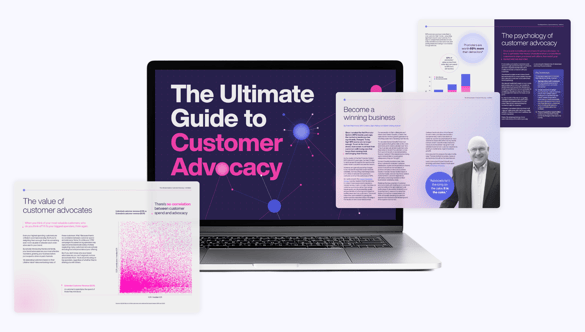The Ultimate Guide to Customer Advocacy
Over the past two decades, marketing has evolved at lightning speed, rendering many businesses’ strategies inefficient and expensive. Winning in the times ahead requires a different approach: an advocacy-first approach.
In The Ultimate Guide to Customer Advocacy, you'll discover strategic guidance, insights, tactics and roadmaps to help you transform your customer economics.
Ready to get started?
Get The Ultimate Guide to Customer Advocacy ebook
What is Customer Advocacy?
Customer advocacy is when your customers are willing to go out of their way to actively shout and recommend your brand, service, or product. More than just having satisfied customers, it's about building deep emotional ties and an undying loyalty towards your brand.
Customer advocates are keen to share their positive experiences in the form of word-of-mouth, social media posts, online reviews, and more, thereby increasing your brand's reach.
Customer advocacy marketing is all about running your business with the customer at its very heart. It's making sure that the minute you offer solution-driven support through whatever products or services you are marketing, all of the customer's needs are at the forefront of your mind.
To truly understand customer advocacy, your customer-obsessed business should always be looking for innovative ways to assist your clients and ensure that their needs are not just met — but exceeded.
This is how you build a cadre of energized, proactive customers who will forever be using your brand to their advantage and going ahead to promote it in front of people. Long-term success is driven by loyal customers who are active brand champions.
Why It Matters
Customer advocates are a huge win for your business. Genuine recommendations from your biggest fans can boost your brand reputation and raise credibility with new customers. These fans go the extra mile to promote your brand; essentially, they are unpaid brand ambassadors.
Such benefits of customer advocacy range from enhancing the brand presence, extending the market share, to making your customers the most fervent brand advocates who cannot afford to see others undermine your product or service.
Customer advocacy, through credible and authentic customer voices, can make sure that your business drives sales further once a relationship is established. And why? Happy customers stick to a brand, further reducing churn and increasing retention rates. This can mean increased sales and revenue through renewals, upsells, cross-sells, and referrals.
This is where customer advocates can be instrumental in offering valuable feedback to perfect the customer experience, thus increasing satisfaction and retention.
Who Are Customer Advocates?
Customer advocates are your huge fans who cannot stop talking good about you. Be it word-of-mouth, social media, online reviews, or any other platform, they scream from rooftops about how wonderful their experiences with your company have been.
These advocates are absolute gold for any business. Glowing testimonials by them can launch your brand's reputation, really cement long-lasting credibility, and help attract top-tier customers.
Types of Customer Advocates
There are four key types of customer advocates that can benefit your business:
- Educator: These advocates are your brand’s storytellers. They share insightful experiences and data that can be transformed into captivating social media posts, informative infographics, and detailed case studies.
- Validator: Your trusty testers who dive deep into your product, offering constructive reviews and feedback. Reward them with early access to new features — their insights will help shape the future of your offerings.
- Status Seeker: Driven by a desire to enhance your brand’s reputation — and boost their own credibility—they’re the perfect mutual partners for brand advocacy.
- Collaborator: The most committed of all, these advocates work hand-in-hand with your team, offering invaluable input on product development and service improvements. They go beyond simple kudos to provide genuine, helpful feedback.
How to Identify Customer Advocates
There are five simple ways to spot those customer advocates in your midst:
1. Define Your Ideal Advocate
Start by crafting a profile of your perfect advocate. Ask yourself:
- Product Knowledge: Do they really know your product inside out? True advocates understand the ins-and-outs of what you offer.
- Value Gained: Are they gaining something big from using your product, service, or resources? Their wish to talk about it with others is positive testimony.
- Willingness to Participate: Are they in a position and ready to participate in activities conducted within advocacy programs and express themselves publicly?
- Marketing Relevance: How much resonance do they have with your target market or ideal customer profile? Your influence will be more effective if it aligns with your core audience.
2. Leverage Customer Data
Your CRM and product analytics are gold mines of information. Use them to:
- Identify High Satisfaction Scores: Look for customers who consistently rate your product highly.
- Track Frequent Users: Regular users are more likely to become passionate advocates.
- Find Positive Interactions: Customers who frequently engage positively with your brand are potential advocates.
3. Monitor Social Media
Your brand’s social media channels are buzzing with activity. Here are the things you'd want to keep an eye out for:
- Active Engagement: Look for customers who consistently comment, share, and like your posts on platforms like LinkedIn and Facebook.
- Positive Reviews: Watch for glowing feedback on review sites and customer forums.
- Brand Promotion: Identify users who go out of their way to recommend your brand in their own posts.
4. Assess NPS Feedback
Your Net Promoter Score (NPS) is a direct measure of customer sentiment:
- High Scorers: Customers who give you high NPS scores are indicating their likelihood of recommending you.
- Criteria Matching: Make sure these NPS stars align with your ideal advocate profile for maximum impact.
5. Ask Your Team
Your internal teams are on the front lines and have insights that are invaluable. Collect success stories by tapping into your sales, marketing, and customer success teams for anecdotal evidence of satisfied, enthusiastic customers. Put in place feedback loops for regular check-ins on new, rising advocates and noteworthy interactions.

How Customer Advocacy Helps Business Growth
Here are seven ways customer advocacy can boost growth for your business:
Building Brand Loyalty
When customers turn into advocates, they develop a much stronger emotional attachment to your brand. This loyalty makes them stick around to help your business—like a pack of friends having your back. They will fight to protect your brand, no matter the odds, and assure you a stable customer base.
Customer Retention
Advocacy creates happy customers who are less likely to leave. To understand how this works in detail, make sure you’re familiar with the latest customer retention metrics, which can show you exactly how advocacy contributes to customers sticking through thick and thin.
Customer Satisfaction
Satisfied customers naturally become advocates. When they love your product or service, they’ll eagerly spread the word to others, creating a positive ripple effect. Their genuine enthusiasm can become contagious, encouraging others to try out your brand.
Boosting Sales Impact
Customer advocates can directly drive sales by recommending your products to friends and family. Their word-of-mouth endorsements are incredibly powerful because they’re trusted and authentic. Why? Because when potential customers hear positive reviews from someone they trust, they’re more likely to make a purchase.
Brand Awareness
Advocates help spread the word about your business, increasing your visibility. This wider exposure draws in new potential customers who might not have discovered your brand otherwise, making your advocates a megaphone, amplifying your brand’s presence in the market.
Customer Acquisition Cost
Reducing costs is always beneficial for business. Advocacy lowers your customer acquisition cost by bringing in new customers through trusted referrals, who not only come at a lower cost but also tend to have up to x2 higher lifetime value, making each new customer even more valuable over time. For more insights, check out this post on the lifetimr.
Customer Insights
Listening to your advocates gives you valuable insights. When advocates share what they love and what could be better, it’s like getting a roadmap to improve customer satisfaction and drive further business growth.
How to Build a Customer Advocacy Strategy
A customer advocacy strategy can help facilitate the process of turning your happy customers into vocal brand ambassadors. These are five elements you need to include for an effective, engaging, and replicable strategy. Tangible Rewards. Show your appreciation with physical incentives and thank-you gifts. Here are some actionable tips:
1. Tangible Rewards
Show your appreciation with physical incentives and thank-you gifts. Here are some actionable tips:
- Branded Swag: Gift them with some good-quality branded merchandise, which could be a T-shirt, a mug, or even a tote. This would be nothing less than a gift, but fast-moving advertising.
- Gift Cards: Gift advocates gift cards to popular online stores or your products. It is very versatile as a form of appreciation.
- Exclusive Discounts: A special code that doles out discounts for your advocates' shopping at your store—rewarding them and also encouraging some repeat business.
Example
Your skincare company could send a box of your latest products to your top advocates along with a handwritten thank-you note. This can be an added touch that strengthens their attachment and really makes them feel appreciated.
2. Acknowledgment
Genuinely realizing an advocate's contribution can help keep their spirits high and continue to advocate for them. Here are some innovative ways:
- Social Media Shoutouts: Make public the top mouthpieces of your brand on various social media channels. Give a shoutout to them in posts and thank them.
- Newsletter Features: A "Customer Advocate of the Month" section in your newsletter. Share their story and how they've positively impacted your brand.
- Advocate of the Month Program: Implement a program with a mechanism to reward and recognize top advocates on a monthly basis. These top advocates should be invited and awarded a certificate, as well as a special prize.
Example
Your software company might feature a monthly blog post interviewing your advocate of the month, discussing how they use your product and the benefits they've experienced.
3. Empowerment
Empower your advocates. Engage them with your brand. Here's how:
- Focus Groups: Allow your advocates to join your focus groups and have their views about product development or how you can improve your different offerings.
- Beta Testing: Let them have the opportunity to beta test new products or features before anybody else. Their input can be used to make adjustments and finesse the beta version into the final version.
- Content Generation: Motivate advocates to create blog posts, videos, or testimonials about their great experiences. Share their content on your platforms.
Example
Your fitness company can have its most loyal clients test a new workout program to be released into the market. Feedback could be sourced with regard to the effectiveness of the program.
4. VIP Treatment
Make your advocates feel special — that they have the opportunity to receive unique experiences that they can be proud to share. Here are some ideas:
- VIP Events: Host special events such as product launch parties, webinars, or exclusive dinners that are invite-only for top advocates.
- Early Access: Provide advocates with early access to new products, features, or services.
- Personalized Services: Offer them personalized customer service or a personal account manager to make sure they get the best service possible.
Example
Huel, the world’s number one complete food nutrition brand, leveraged Mention Me data and celebrated Huel advocates by offering them a chance to win exclusive tickets to their sponsored event, Soccer Aid UK, a celebrity charity soccer match.
This special treatment not only delighted their advocates but also strengthened their loyalty, turning them into even more fervent Huel ambassadors.
5. Influencer Engagement
Collaborating with influential advocates can significantly broaden your brand’s reach. Here’s how to do it effectively:
- Identify Influential Advocates: Look for customers who already have a significant following on social media. They are your potential influencers.
- Collaborate on Campaigns: Collaborate on marketing campaigns, new product lines, or brand events with influencers, whose word can help spread the message.
- Leverage Their Credibility: Influencers let you ride on their level of trust to immediately get people believing in you, and a great way to capture new audiences.
Example
Your fashion brand could collaborate with a popular fashion blogger who loves your products, featuring them in a campaign that showcases how to style the brand’s latest collection.
Steps to Drive Customer Advocacy
To turn these elements into action, follow these steps to drive customer advocacy:
Step 1: Prepare
Name one team member to be responsible for driving the strategy. Develop a clear plan to know how you will communicate with, and recruit the customers as your advocates. Then, engage the help of the marketing and customer service teams to support the strategy and to keep in the direction of your overarching goals.
Action Tip: Kick-off meetings with cross-functional teams to ensure everyone is on the same page. Create a shared document that outlines roles, responsibilities, and timelines.
Step 2: Set Goals and Objectives
Set clear, measurable objectives for your customer-advocacy marketing. Objectives can include increasing customer referrals by X percentage to gain a wider share of voice for your brand, building a community of loyal customers, improving brand perception, and increasing customer satisfaction.
Action Tip: Use SMART objectives — Specific, Measurable, Achievable, Relevant, and Time-bound. For example, “Increase referral rates by 20% within the next quarter.”
Step 3: Identify Potential Advocates
Look for highly engrossed consumers — those constantly involved in social media, blogs, or events. Look for more reputed people, those with a high count of followers — they'll be the ones to end up as the hard-core advocates.
Action Tip: Use tools like social listening and CRM analytics to pinpoint who’s already championing your brand. Create a customer segmentation list to keep track of potential advocates.
Step 4: Develop Strong Customer Relationships
Treat your advocates in a friendly manner and relationally. Allow them to test your new products and let them leave comments, so that they know you care about their answers. And of course, one should never forget that trust is fundamental for a long-term relationship of advocacy.
Action Tip: Implement a loyalty program that offers exclusive benefits to your advocates, such as early access to sales, special events, or personalized thank-you notes.its to your advocates, such as early access to sales, special events, or personalized thank-you notes.
Step 5: Focus on Communication
Build open and continuous communication channels through online communities, survey sites, or forums. Listen and act on the feedback from your brand advocates that can work toward the improvement of your product or service offering. Serve them appropriately by using NPS surveys to know how far their advocacy can go.
Action Tip: Launch a closed Facebook group or a Slack community where advocates can mingle, share feedback, and feel part of an exclusive club. Use NPS surveys to gauge their advocacy levels and identify improvement areas.
Step 6: Build Your Strategy Back Into Your Brand
Automate customer advocacy into the company process and institutionalize it as an organizational culture. Value and involve the advocates in your company's activities, and continuously grow those relationships over time to ensure an ever-growing advocacy drive. Standardizing strategy helps maintain momentum and keeps advocacy efforts aligned with business goals.
Action Tip: Create an advocacy playbook that outlines processes, best practices, and KPIs. Regularly train your team on the importance of customer advocacy and how to maintain these relationships.
How to Implement a Customer Advocacy Program
Implementing a customer advocacy program involves several key steps:
1. Collect customer feedback
Start things off right by taking a few of your own early cues from customers. Use surveys and feedback forms, along with in-person chats, to understand. From these insights, you'll find ideas that hold the key to crafting your program.
Listening and taking action on what is said by your customers is a source of developing trust and loyalty. Turning them into brand evangelists begins with building a community.
2. Build a community
Build a space that allows your customers to connect, share experiences, and feel likethey belong to something bigger. This can be an online forum, a social media group, or regular customer events.
Social listening fosters feelings of loyalty and engagement with your customers. When they perceive they have a connection with others who love your brand, they're more likely to be brand advocates.
3. Improve your customer service
Amazing customer service is the backbone of customer advocacy. So, make your service superb in order to maintain the satisfaction and engagement of your customers.
Teach your team to be responsive, empathetic toward customers, and solution-oriented. When a customer experiences truly great service, he or she will likely tell friends and family members about it. Great service turns satisfied customers into avid followers.
4. Voice Platform for Customer Testimonials
Create a platform where customers can share their success stories and testimonials. This can be a section on your website, a social media campaign, or even video testimonials.
Such real-life stories from satisfied customers carry quite a strong persuasive power, as they inspire other consumers. Proving your brand to these people can make your supporters feel proud and contribute to its building.
For more tips on how to nail your customer advocacy marketing strategy, it’s best to learn the 6 ways of influence.
How to Measure the Success of the Customer Advocacy Program
Tracking customer advocacy is crucial to understanding the impact of your efforts over time. While it can be tricky to measure, these metrics and methods can help:
Net Promoter Score (NPS)
Start by asking your customers a simple yet powerful question: "On a scale of 0-10, how likely are you to recommend us to a friend?" Based on their responses, categorize them into:
- Promoters (9-10): These are your biggest fans who will rave about you to others.
- Passives (7-8): They’re satisfied but not enthusiastic enough to promote.
- Detractors (0-6): These are unhappy customers who could harm your brand’s reputation.
To calculate your NPS, subtract the percentage of Detractors from the percentage of Promoters. This score will give you a clear picture of your overall customer loyalty and advocacy.

Referral Tracking
Want to know how word-of-mouth is working for you? Track the number of new customers who are a result of a referral. Referral tracking software or unique codes can help in this respect. It doesn't only help you understand your results with advocacy but also shows who your top advocates are.
Social Media Engagement
Social media is, therefore, a gold mine for tracking advocacy. Track comments, likes, shares, and mentions to understand the proportion and frequency of customers saying positive things about your brand. High levels of engagement can be indicative of high levels of advocacy. Various tools are also available to monitor these activities and calculate the score, such as social media analytics.
Customer Testimonials and Reviews
Monitor the sentiment of reviews on a regular basis on platforms such as Google, Yelp, and other industry-specific review sites. Positive comments on such platforms act as social proof for creating attraction for potential prospects.
Customer Surveys
Regular customer surveys are essential for gauging satisfaction and willingness to recommend. Include questions that assess overall satisfaction and the likelihood of referrals.
Ask open-ended questions to gain deeper insights into advocacy behaviors and the reasons behind their recommendations. Surveys offer direct feedback, helping you understand what drives advocacy. On average, a customer lifetime value is a view of the future cash flow per customer.
Customer Lifetime Value (CLV)
Monitor repeat purchases and referrals while learning about the long-term impact of your advocacy efforts. CLV allows you to measure the monetary value of turning customers into advocates — the impact they have in business for your bottom line over time.
Social Listening Tools
Use a social listening tool to monitor your brand mentions. Monitor the sentiment in those mentions and keep an eye on abuses of the growing discussion on customer advocacy. Your business can measure brand advocates and their reach and impact. Social listening can make sure you can track every mention of your brand.
Accelerating growth for leading brands














Get the ebook
Marketing is no longer working how it should. Change your strategy now – before it’s too late.
Our Ultimate Guide arms you with all the insights you need to start putting an advocacy-first strategy into practice.
Featuring brand success stories, powerful stats, and contributions from NPS creator Fred Reichheld, this ebook will put you on the path to transforming your customer economics through the power of advocacy.
Get The Ultimate Guide to Customer Advocacy ebook

Your ultimate guide to thinking advocacy-first
Discover our case studies
See how other ambitious brands are driving sustainable growth and hitting their key business goals through customer advocacy.

“We’ve seen exceptional results in the six years we’ve been working with Mention Me. It’s played an important role in turning our loyal community of Hueligans into a significant revenue stream, helping to acquire valuable customers at a lower cost to other channels.”

Emily Hollis
Senior CRM Executive

“Our CEO used to go to a bag show and honk his car horn until people came around to look at our bags. Mention Me takes that same mechanic and puts more data and science behind it. It’s word of mouth on Red Bull.”

Luke Collins
Chief Commercial Officer

“Mention Me was an easy choice. Our programme’s performance is constantly improving, and its CPA is consistently cheaper than our other channels. It’s been a game-changer for us. ”

Diane Larramendy
Chief Operating Officer



